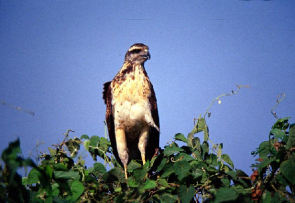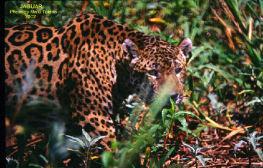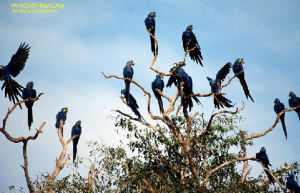|
Southern Pantanal - Brazil |
|
Destinations |
 |
 |
 |
|
The Pantanal is an
ecological paradise right in the heart of Brazil. It is the
largest flooded lowland on the planet and the third largest
environmental reserve in the world. Its ecological importance is
immense, since it is home to one of the richest ecosystems ever
found to date, with periodically flooded seasonal forests.
It displays the largest concentration of neo-tropical fauna,
including several endangered species – mammals, reptiles and
fish – and it also serves as habitat for an enormous variety of
native birds, as well as those migrating from other areas in the
Americas.
The Pantanal is one of the best places in Brazil for flora and
fauna observation and for fishing – permitted only between March
and October – due to its abundance of animals. It has a total
area of 230 thousand square kilometres, covering 12 townships in
the States of Mato Grosso and Mato Grosso do Sul. To the North,
there are the Paracis, Azul and Roncador mountains. To the East,
the Maracaju Mountain Range. To the South, the Dodoquena
Mountain Range. And, to the West, the Paraguayan and Bolivian
swamps. The Pantanal is so diverse that researchers subdivided
it in sub-regions. Each “Pantanal” – North and South – has its
own natural features, activities and ideal period for
visitation.
There is a lot to see and enjoy throughout the entire region. In
the South Pantanal, the most prominent site is the Pantanal Park
Road. Its 117 km of dirt road and 87 wooden bridges – many of
which are in precarious condition – connect Corumbá to the
Buraco das Piranhas (Piranha Hole). If this tour is done by car,
it is possible to observe countless wild animals along the way,
such as alligators, capybaras, macaws, wood ibises, caracaras,
deer and anacondas. They hide around the bays and canals that
take the water from the swamps to the rivers. After that, you
arrive at Manga Port, where the vehicles cross the Miranda River
(it is best if pick-up trucks or jeeps are used since they are
more appropriate for the pot-holed roads, sand banks and
undulations. There are some inns on the other side of the river,
and some of these are dedicated to fishing expeditions.
The best time to visit is between May and September, when there
is less rain. From March to April, when the waters begin to
recede, fauna observation is at its best. During the rainy
season, between October and February, there are a great many
mosquitoes, the heat is very intense and the Transpantaneira
Highway is practically impassable.
Corumbá
Corumbá is a river port located on the right bank of the
Paraguay River, on the border with Bolívia. It is one of the
largest towns in Mato Grosso do Sul and one of the main gates to
the Pantanal. It is located 435 km from Campo Grande, the state
capital. Its name comes from Tupi-Guarani and means “distant
place”.
Corumbá is located at the extreme west of Brazil. For many years
it was almost only reachable by the Paraguay River. Today, it is
possible to get there by car, coach, train, airplane, and,
obviously, by boat.
Aquidauana
Located in the South Pantanal, Aquidauna is an authentic
paradise, populated by exuberant species of fauna and flora
spread over enormous flooded lowlands, formed by bays, hills,
ridges, flooded lowlands, and outlets. It is one of the entrance
gates for the South Pantanal National Park and it is in a
privileged location in the Piraputanga Mountain area.
During the 16th century, the Spaniards founded the village of
Xaraes, where the town originated, along the banks of the
Aquidauna River. The local Indians call it the Xaraés Sea.
Miranda
Miranda is considered the Gateway to the South Pantanal, since
its large flooded lowlands start almost inside the town. From
the moment the tourist enters the Gateway he/she will find
typical Pantanal flora on both sides of the highway, as well as
many species of fauna, especially birds. Tourists will find
several attractions, such as camping grounds, hotels, fishing
grounds, and more.
The town of Miranda is part of the Paraguay Basin. The town’s
main waterways are the Miranda, Salobra, and Agachi Rivers. The
meeting of the crystal clear waters of the Salobra River and the
cloudy waters of the Miranda River is an attraction no one
should miss.
Indigenous Communities – Terena Indians
The Terena indians are the second largest ethnic group in the
State. They are mainly concentrated in the Miranda and
Aquidauana area. It is one of the most literate groups in
Brazil, especially the works by Roberto Cardoso de Oliveira.
-
Basic information
-
Climate
In the Pantanal, the dry season starts between May and
September, and it is accompanied by cold weather – the average
temperature is around 21°C. From October to February, the rainy
season, it becomes very hot – the average temperature is 32ºC –
and there are enormous quantities of mosquitoes. The
intermediate season – the best time for visitation – is well
balanced, with little rain and good conditions for fauna
observation.
-
Events
-
Pantanal
Micareta (out of season Carnival)
Aquidauana’s biggest event is the Pantanal Micareta, which
attracts thousands of tourists to Dr. Sabino Avenue, annually.
Period of fish migration (for spawning)
During the months of November to January, fishing is prohibited
on the rivers of Mato Grosso do Sul state. In the fishing
resource reservation area prohibition extends until February.
-
Accommodation /
Restaurants
-
In Miranda –
Gateway to the South Pantanal – one can find small inns as well
as enormous farms and ecotourism hotels.
As for the cuisine, the menus are filled with what is abundant
in the area: richly prepared and served fresh water fish.
See more in:
http://www.miranda.ms.gov.br/
-
How to get there
-
By Highway:
leaving Campo Grande, take the BR-262 federal highway to the
first town, which is Aquidauana, 148 km away. It is 73 km to
Miranda. From there, the road has no shoulder and cattle and
wild animals frequently cross it. There are another 370 km to
Corumbá.
-
Services
-
- Corumbá:
Sematur – Tourism Information: +55 (67) 231-7336
Coach Station: +55 (67) 231-2033
Airport: +55 (67) 231-3322
- Aquidauana:
Coach Station: +55 (67) 241-2501
Bank Branches: Banco of Brasil, Bradesco, CEF, HSBC and Itaú
Regional Hospitals: +55 (67) 241-3636
- Miranda:
Coach Station: +55 (67) 242-1409
Bank Branches – Banco of Brasil, Bradesco and HSBC
-
-
Attractions
-
São Lourenço
River
Located in the heart of the Pantanal region, this river has
pacus, pintados and cacharas (all fresh-water fish). Dorado
fishing with artificial bait is very productive, especially
among the tree branches touching the water. It is advisable to
hire a guide who knows the less frequented spots. The best time
for fishing is from July to November.
Paraguay River
The Paraguay River is the Pantanal’s backbone. It cuts through
the region from North to South. The Miranda, Aquidauna, Taquari
and Cuiabá rivers flow into the Paraguay River. From October to
April, the high waters reveal enormous lakes, bays, river
branches and outlets.
In Corumbá
House of the Sculptor
At the Izulina Xavier Art Centre artifacts crafted in stone and
concrete powder, ceramic and wood engraving are displayed. It is
open from 8 am to 5 pm, during weekdays.
Our Lady of Candelária Church
This church, inaugurated with a formal ceremony in 1877,and
located facing the Praça da República, has a coat of arms from
the Portuguese Crown on its altar.
Maria Auxiliadora Sanctuary
There is a hardwood sculpture from the 1950s in the sanctuary
made by the plastic artist Burgoso – Pablo Picasso’s friend.
Burgoso lived in Corumbá and left several art works in wood and
plaster. The Sanctuary is located on Rua Dom Aquino Correia and
is open from 1 pm to 8 pm.
House of the Pale-Legged Ovenbird
It was created as an incentive to ceramic art. Its artists are
children and adolescents who sculpt Pantanal plants and animals
in clay.
Health Well
Near the House of the Pale-Legged Ovenbird there is a spring of
cold, crystal-clear water. One can admire the stone bed where it
is formed. Some people believe its water is medicinal. It has a
gateway that opens to the Park, and it was inaugurated in June,
2003.
Artisan’s Centre
In this building, which used to be a public jail until the 70s,
the tourist will find articles in leather, wood and ceramics
made by local artists, in addition to indigenous arts and
crafts. There are also delicious homemade liqueurs. There is no
report on how long ago this ancient building was constructed,
only of its remodelling in 1893. The centre was founded in 1975
and the cells were made into stores or small workshops.
Republic Square
This spot, which was the setting for the final battle staged to
retake Corumbá in 1867, boasts a marble obelisk honouring the
Paraguay War heroes.
Luiz de Albuquerque Institute
In the museum, one will find stuffed animals, articles from
several local indigenous tribes, classes in plastic arts and
arts and crafts in leather and clay, utensils used on centennial
farms, personal objects from the Pantanal’s first explorers and
Marechal Cândido Maria da Silva Rondon. The French architecture
building, constructed in 1922 to house an elementary school, was
remodelled to be used as a museum, with two libraries.
Ladeira Cunha e Cruz
Also known as “Ladeira da Candelária”, it is one of the main
accesses to Porto Geral and the Paraguay River. Its name is in
honour of a Brazilian troop captain who defeated the
Paraguayans.
Escadinha da Quinze
Its 126 steps take one from the town’s high section down to
Porto Geral. It was built in 1923, and has since then been
remodelled by the Town Administration. Located in the centre of
General Rondon Avenue and Quinze de Novembro Street, it provides
an unforgettable view of the Paraguay River and the Pantanal.
Independence Square
It is the site of the town’s old zoo. There are only three
squares, two in Brazil and one in Germany, with this
architectonic style. It has an octagonal gazebo imported from
Germany, which is where the mosaic for the external paving came
from, too. The four sculptures, representing the four seasons,
were made in Pisa, Italy, and donated by an Italian count who
came hunting in the Pantanal. The region’s native plants such as
rosewood, bocaiuva, and ipe-roxo, integrate the diversified tree
growth.
Forte Coimbra
Located in an area of difficult access – only planes or boats
can get there – it was built in 1775 to protect the Brazilian
territory against Spanish invasions. It was also a setting for
battles during the Paraguay War. In 1975 it was decreed a
landmark and today houses the 18th Army’s Infantry Border
Brigade.
Casario do Porto
In 1814, the Port was Latin America’s third largest.
Transatlantic ships docked here, to unload merchandise from
Europe to sell and trade in Brazil. Declared a National
Historical Heritage in 1992, this postcard still shows signs of
its period of great prosperity. The buildings had large
emporiums, 25 international bank branches, tanneries and the
first ice factory in Brazil. The Wanderley Baís & Cia building,
constructed in 1876, is one of the most beautiful at the port.
Today, the Municipal Secretary for the Environment and Tourism
and the Pantanal Culture Foundation operate from there.
Another large house with equal architectonic value is the
Vasquez & Filhos house, built in 1909 by the Italian architect,
Martino Santa Lucci.
Junqueira Fort
This fort was built in 1871, soon after the Paraguay War. It is
located in a privileged area from where one can oversee the
Pantanal. The 12 cannons manufactured in England were never
used. The walls are made of limestone and are half a meter
thick. The Fort, located in the 17th Hunter’s Batallion Barracks
received its name from José Oliveira Junqueira, minister of war
during the time of its construction.
Park Road
Along the road’s 120 km and 87 wooden bridges, one can sight
birds, mammals and alligators. Manga Port is located along the
Park Road. The Port stands out because of its marvellous
demonstration of flora, including ipês, bocaiúvas and animals
living in perfect harmony. Take BR-262, from the Buraco das
Piranhas, and proceed towards Passo do Lontra; or, from Corumbá,
head toward Manga Port.
Ladário
This town, which borders Corumbá, has about 15 thousand
inhabitants and is home to the largest river base in Latin
America. The gateway to the 6th Naval Marine District was
installed in 1872 and is called the Pantanal’s Arc de Triomphe.
In Aquidauana
Pantanal Art Museum
Named "Rubens Corrêa", the museum honours the great actor from
Brazilian theatre and Globo TV, who was born in Aquidauana. The
place stages countless cultural manifestations.
Ecological Park of Comprida Lagoon
This environmental preservation area comes with a jogging track
and a leisure area. The place will soon be completely
reorganised in order to provide better conditions for tourists
and visitors.
Old Bridge
Only one car at a time can cross over this bridge. The iron and
wood structure are solid for traffic. It is known as the bridge
of friendship and it connects the townships of Aquidauana and
Anastácio.
In Miranda
Historical Monuments
Miranda has a great number of old buildings and monuments, which
recount its history. Most buildings are used as residences
today. Among these, the most prominent are the Paraguay War
monument located in the old section of town; the bridge over the
Salobra River, built in 1931, and of English construction,
brought over by steamship up the Miranda River; the Miranda
Railroad Station, one of the oldest in the state of Mato Grosso
do Sul, built in 1912; the Santo Antônio Sugar Mill Building,
built in 1900, in French style; the religious complex that
unites the Our Lady of Carmo Mother Church and the old residence
of Priests and Nuns, located on Agenor Carrilho Square and built
in 1930; the Old Town Hall Building, located on Carmo Street and
where the town council operated, and which will soon be
renovated and made into a Paraguay War Museum.
The Noroeste do Brasil Railroad Station Cultural Complex
The oldest railroad building in the State of Mato Grosso do Sul
was inaugurated on December 31, 1912, to be used for boarding
and disembarking. It is part of the Federal Railroad Network
architectonic complex and the Mato Grosso do Sul Historical
Heritage. It was greatly responsible for the social-economic
development of the township during the time it was inaugurated,
and then it went through a long period of abandonment. It was
completely renovated and became the Cultural Centre where the
Department of Tourism, the Department for Sports and Leisure,
and the Railroad Museum are currently located. Banners, photos,
articles and documents are exposed that recount the history of
Miranda’s railroad; and there is also the Artisan’s Centre, and
the Fish Platform Bar where fish from the South Pantanal are
served.
Artisan’s Centre
The Artisan’s Centre of Miranda was inaugurated in July 2002,
and it is located in the Railroad Station building. The purpose
of the Artisan’s Centre is to congregate the work of
professionals until now spread about several points in the town.
The most used raw materials are wood and clay, very abundant in
the region, and which are transformed into beautiful art pieces
mainly portraying Pantanal fauna.
|
|